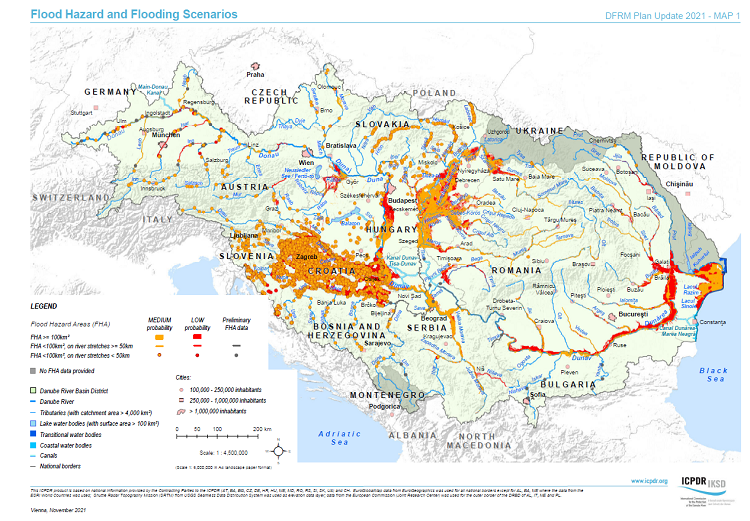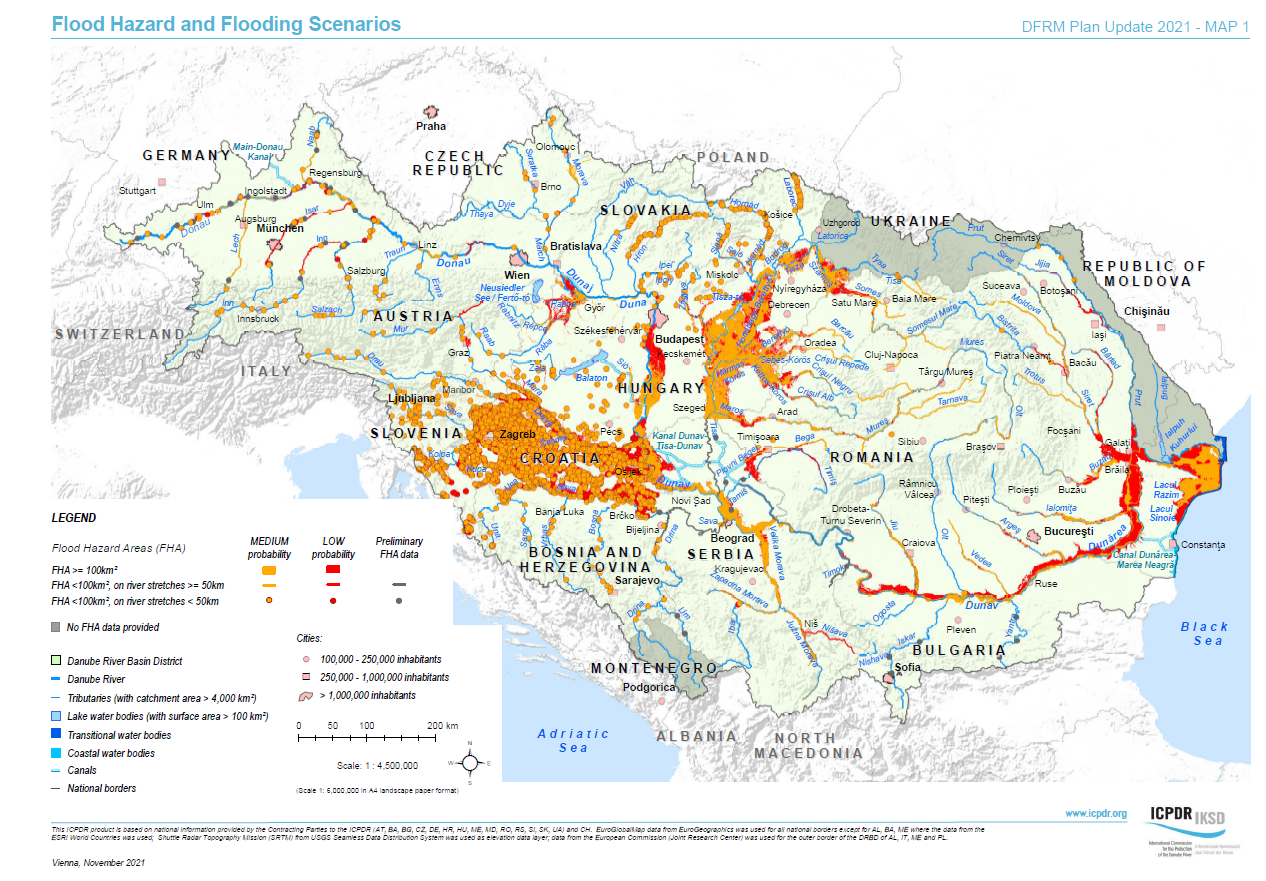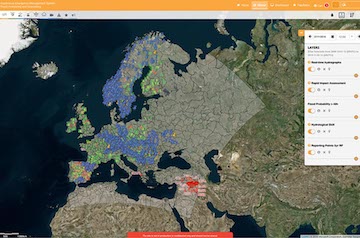
by Valéria Wendlová, Slovak Hydrometeorological Institute
The International Commission for the Protection of the Danube River (ICPDR) adopted at its 24th Ordinary Meeting Danube Flood Risk Management Plan (DFRMP) Update 2021. The document is processed under the EU Directive 2007/60/EC on the assessment and management of flood risks (EU Floods Directive, FD) by all member states every six years.
The DFRMP Update 2021 – the first update to the plan firstly published in 2015 – represents a key step forward in the ICPDR’s work towards sustainable flood risk management. It strengthens various aspects of flood risk management focusing on prevention, protection, and preparedness, including measures for achieving the established objectives, and calls for solidarity among all ICPDR Contracting Parties.
The main documents involve information and all data in numerical form and maps. The first document which was processed was Preliminary Flood Risk Assessment (PHPR) and presented information on major flood events that occurred in the Danube River Basin District focusing primarily on the last two decades and assessed new areas with significant flood risk
This document also provided a brief description of the methodology used at the national level for the identification of areas of potential significant flood risk as required by FD Article 5 as well as the methodology agreed by the ICPDR to identify the areas of potential significant flood risk in the Danube River Basin District including those having a transboundary character.
The PHPR report set the necessary basis for the update of flood hazard and flood risk maps and for the preparation of the Danube Flood Risk Management Plan Update 2021. At the same time, it provided the public and stakeholders with important evidence that the areas with potential flood risk in the Danube River Basin are being taken care of for the benefit of all inhabitants and countries of the Danube River Basin.
Important parts of the document in DFRMP are Flood hazard maps and Flood risk maps. They were prepared for the catchments with an area larger than 4000 km2 to ensure a coherent approach with river basin management planning. These maps show the potential adverse consequences associated with different flood scenarios and serve as an effective tool for information, as well as a valuable basis for priority setting and further technical, financial, and political decisions regarding flood risk management.

Article 7(2) FD stipulates that the Member States shall establish appropriate objectives for the management of flood risks for the areas identified under Article 5(1), focusing on the reduction of potential adverse consequences of flooding for human health, the environment, cultural heritage, and economic activity, and, if considered appropriate, on non-structural initiatives and/or on the reduction of the likelihood of flooding.
The ICPDR agreed upon the following objectives of the Flood risk management plan for the Danube River Basin District:
-
Avoidance of new risks
-
Reduction of existing risks
-
Strengthening resilience
-
Raising awareness
- Promoting the solidarity principle
These objectives focus on the reduction of potential adverse consequences of flooding for human health, the environment, cultural heritage, and economic activity and address all aspects of flood risk management focusing on prevention, protection, preparedness, including flood forecasts and early warning systems and taking into account the characteristics of the Danube River Basin District.
During the first flood risk management cycle, the ICPDR flood experts were carefully considering if all appropriate objectives are able to sufficiently cover - at the basin-wide level - all needs for the management of flood risks. The main conclusion was that the defined objectives were broad and robust enough to accommodate all relevant topics including the impacts of climate change.
The progress in achieving of basin-wide objectives of the DFRMP is addressed primarily through the implementation and communication of best practice projects and all countries provide some examples. By highlighting the successful cooperation between the Danube countries in international projects and/or joint initiatives (e.g. promoting the solidarity principle during Danube ice event 2017) on flood risk management the need for cooperation and coordination is underpinned.
The measures described in the plan address all phases of the flood risk management cycle and focus particularly on
- prevention (i.e., preventing damage caused by floods by avoiding construction of houses and industries in present and future flood-prone areas or by adapting future developments to the risk of flooding)
- protection (by taking measures to reduce the likelihood of floods and/or the impact of floods in a specific location such as restoring flood plains and wetlands) and
- preparedness (e.g. providing instructions to the public on what to do in the event of flooding).
Preparedness is a result of awareness and is based on the necessary information to make the individual recognize his possibilities of action. Problems associated with floods are often not sufficiently recognized and acknowledged. The authorities should ensure that the information concerning flood prevention and protection plans is transparent and easily accessible to the public. The information provided to the affected communities should also include communication of opportunities how they can adapt e.g., their land-use practices to natural circumstances on floodplains. All measures linked to public information and awareness-raising are most effective when they involve participation at all levels.
An important measure in DFRMP concerning the warning of the population is the EFAS. EFAS was developed in close collaboration with the ICPDR and the national hydro-meteorological services sharing the Danube River basin amongst others. The aim of EFAS is to provide the time for preparedness measures before major flood events strike, particularly for large trans-national river basins such as the Danube, both on the country as well as the European level. This is achieved by providing complementary, added value information to the national hydrological services and by keeping the European Response and Coordination Centre informed about ongoing floods and about the possibility of upcoming floods across Europe. Since 2012 EFAS has been running fully operational as a part of the Copernicus Emergency Management Service.
EFAS provides the national authorities a wide range of flood forecast information such as medium-range flood forecasts with a lead time of 10-15 days, impact forecasts, flash flood forecasts with up to 48 hours lead time, and seasonal outlooks for the coming months. The information can be accessed by the EFAS partners either through a password-protected website or through web services. All relevant flood forecasting authorities in the Danube River basin are EFAS partners.
Through collaboration at the Danube River basin as well as at the European scale EFAS fosters knowledge exchange and data sharing amongst the national hydro-meteorological authorities and hence is an essential tool to improve overall flood risk management in the Danube River Basin.
The updated Plan presents the strategic basin-wide level measures to prevent and reduce damage to human health, the environment, cultural heritage, and economic activity. Special attention in the DFRMP Update 2021 is given to measures employing areas that have the potential to retain floodwater, such as natural floodplains as well as the other areas enabling controlled flooding. In the frame of their prioritisation, those measures were favoured which are sufficiently robust to the uncertainty in forecasting of climate change impacts. This robustness has been achieved through focusing on pollution risk in flood-prone zones; on the application of non-structural measures when possible, and on “no-regret” and “win-win” measures. The major ICPDR platform for joint implementation of the strategic level measures is the transboundary projects supporting DFRMP. The progress in implementing DFRMP measures was assessed through evaluation of the achievements of international projects.
The elements of the Danube Flood Risk Management Plan will be periodically reviewed in the future on a regular basis respecting the flood risk management planning periods, and after each review, they will be updated to reflect the latest level of knowledge. Reporting on the Danube Flood Risk Management Plan implementation progress will be done via national representatives in the ICPDR Flood Protection Expert Group.
Reference: https://icpdr.org/main/2021-updates-danube-river-basin-flood-risk-management-plans-published

